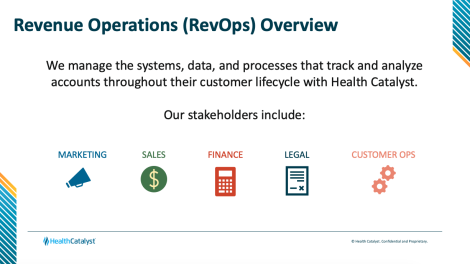
The Future Of RevOps Automation and World Domination
Ali Rastiello is a seasoned expert in RevOps and a valued Openprise customer. She joins us as a guest author with a wealth of experience and keen insights into evolving trends. Ali shares her invaluable perspectives and innovative RevOps approaches that promise to blend her expertise with actionable advice.
When people ask me what I do, and I tell them my job title, they usually look at me a little like a confused puppy. Head slightly cocked, eyebrow raised, trying to process the words I’ve said. They understand each of them but aren’t sure what they mean when put together in terms of a RevOps Automation job function.
Hi, I’m Ali Rastiello, VP of Revenue Operations… *Confusion* … insert another 47,000 words to explain what that means. This is literally the exact conversation I have over and over again, trying to explain my professional life for the last few years.
And I’m not talking about explaining it to my friend’s mom or my cousin’s husband, who have no idea what it’s like to work in corporate B2B environments. I’m talking about people in this space, in our industry, in leadership roles, and in teams that RevOps Automation roles support who are honestly confused by what we do on a daily basis.
So, why is that? It’s not like the concept hasn’t been around for a while. Yet, according to the Openprise 2024 State Of RevOps survey, only 35% of B2B companies have a formalized RevOps function.
I was introduced to the term in my early days at BigCommerce, circa 2017. I wasn’t receptive to it, honestly. The idea of being a marketing operations leader and not sitting in marketing seemed like a foreign concept. It felt like it would deliberately silo the marketing team from the systems, data, and support they needed to effectively run their function while keeping the marketing ops team out of the critical, strategic conversations they needed to participate in to build their roadmaps.
However, the more I grew in my marketing ops leadership role, the more I struggled to get what I needed from adjacent ops teams. Whether it was prioritizing my projects by whoever in the company owned Salesforce or arguing with a centralized analytics leader with no marketing experience about KPIs and dashboard needs, I started coming around to the concept. I now see how bringing these teams together the right way could be incredibly powerful in enabling scalable growth for a company.
A few weeks ago, I pulled together a presentation for our marketing team covering some changes in our sales organization and took the chance to double down on my team’s mission. I wanted to help them truly understand the breadth of what we cover, what teams we support, and why it’s essential to have marketing and sales ops functions aligned under one leader. I wanted a single statement that helped articulate the work we do. I came up with the following: We manage the systems, data, and processes that track and analyze accounts throughout their customer lifecycle with Health Catalyst. I also showed a visual of all of the teams we support.
Is it some sort of poetic genius? Nah. I don’t even know if it’s my original thought or simply an amalgamation of everyone’s opinion of what RevOps Automation should be. But I do think it resonated with them, so I’m keeping it. For now, anyway.
The next question I often get asked is, “Where should RevOps sit in the company?” That is a question for the ages, friends.
Going back to the Openprise State of RevOps survey, 41% of teams sit under the CRO, 21% sit under the CFO, and 10% under the COO. After that, it’s single digits for other functions, including only 5% reporting to the CMO.
People have BIG feelings about this. Marketing wants RevOps to sit with them so that they feel in control of their performance narrative. Sales would like it to sit with them because they want control of Salesforce and all of the sales process, from deal origination to contract signing. Finance wants RevOps in their org so they have deep insights into revenue and control of such a significant technology spend.
I honestly think it doesn’t belong with any of those functions. It’s too important to be a secondary function in an org or worse yet, an afterthought. In my dream of total world domination, I envision RevOps being part of an actual business operations function, reporting directly to the CEO and solely focused on all of the core systems for a company. In my perfect world, all systems touching the customer lifecycle would live in one team, be integrated, and teach the world to sing in perfect harmony.
Or, at least, it should be able to show the entire customer journey and trigger system updates based on where the customer sits in their lifecycle. It should also surface customer data at the right times to the right teams so everyone can have what they need to service the customer at their fingertips. I want it to be the Oprah of systems—YOU GET A CAR! YOU GET A CAR! EVERYBODY GETS A CAR! etc… but, you know, with relevant customer data.
If you want to hear me talk more about this, join me at RevOpsAF 2024! I’ll be on a few panels discussing the future of RevOps, how to build a strategic RevOps function, and using AI for good with my friends from Openprise. I’m bringing some folks from my team and can’t wait to hang out with other awesome people who are passionate about making RevOps the standard practice for all operations. Grab me at the hotel bar for a cocktail, good conversation, or even a spirited debate about where RevOps is headed! I’m always up for a good sparring match!
Recommended Resources















